Business Management Report: Structural Failures in Construction
VerifiedAdded on 2023/01/17
|12
|3852
|62
Report
AI Summary
This report delves into the critical aspects of business management within the construction industry, specifically focusing on structural failures, the impact of poor quality materials, and quality management practices. It examines structural failures, including their causes and associated costs, emphasizing the importance of preventing such issues through effective design and material selection. The report also explores the detrimental effects of substandard materials on the supply chain, highlighting how they can lead to project delays, increased costs, and reputational damage. Furthermore, it investigates quality management theories and practices in civil project building, emphasizing the role of quality control, adherence to standards, and the application of scientific and contingency management theories. The research employs a thematic analysis approach to investigate structural failures and offers valuable insights for construction companies, particularly in preventing defects and ensuring the successful completion of projects. The report uses Jacobs's Engineering constructions company in Battersea power station as a case study.
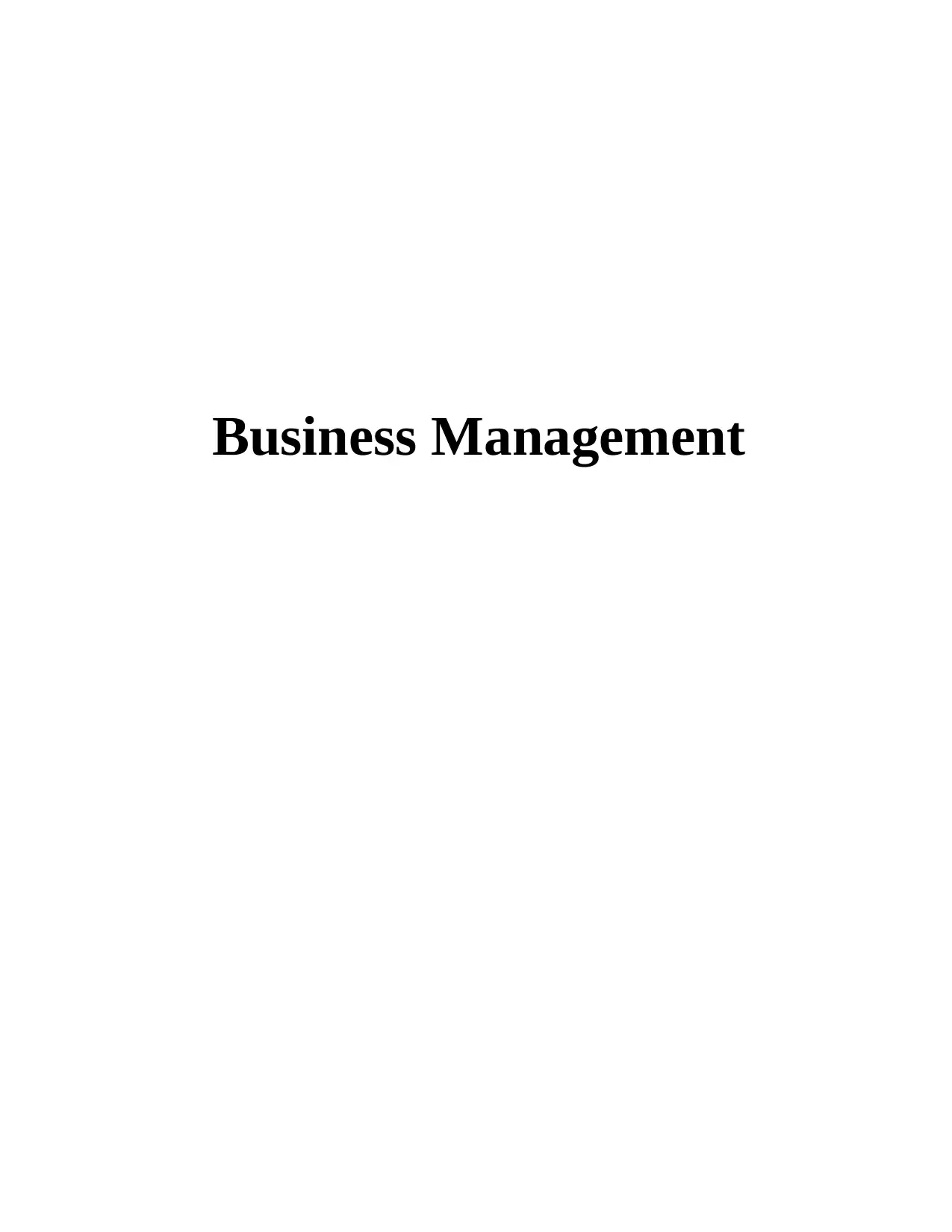
Business Management
Paraphrase This Document
Need a fresh take? Get an instant paraphrase of this document with our AI Paraphraser
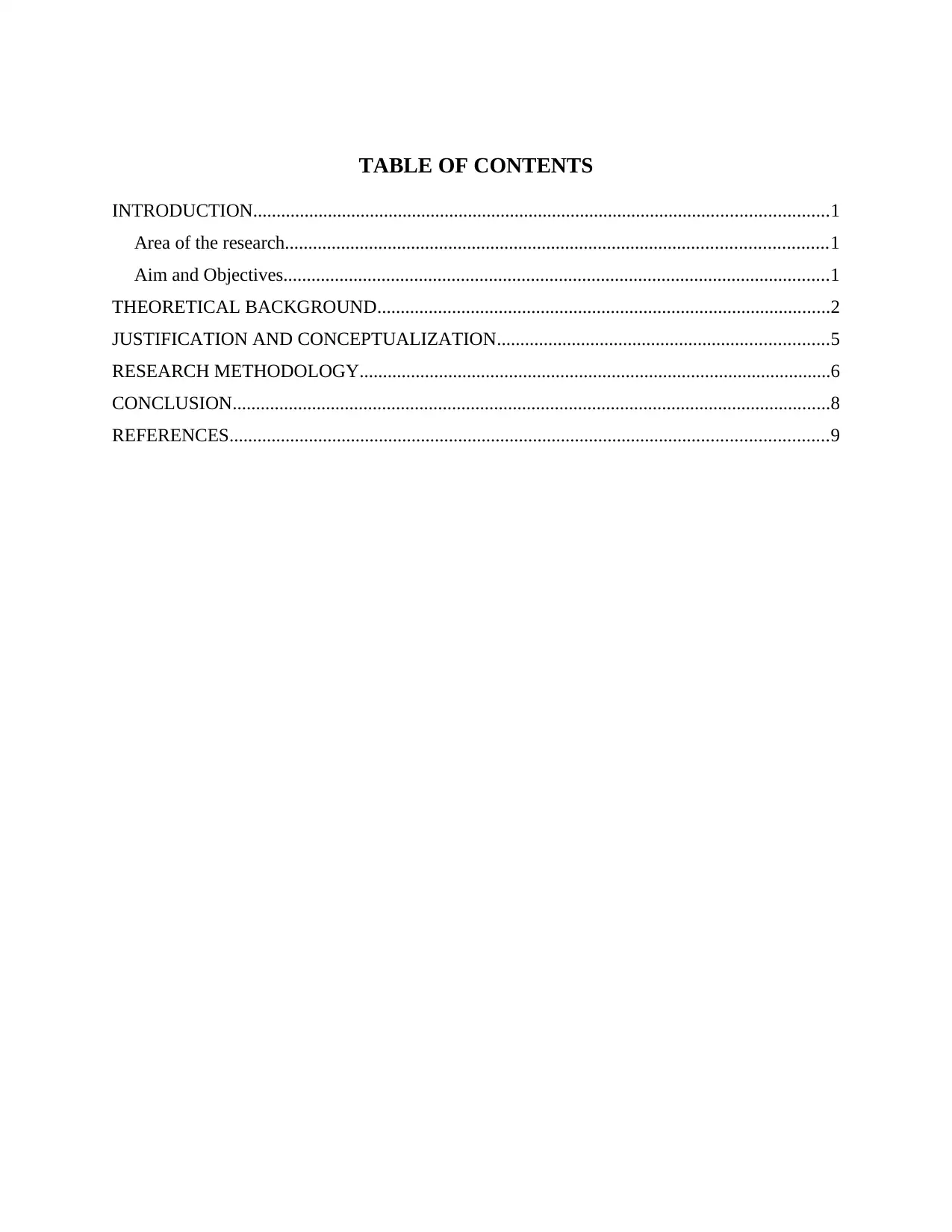
TABLE OF CONTENTS
INTRODUCTION...........................................................................................................................1
Area of the research....................................................................................................................1
Aim and Objectives.....................................................................................................................1
THEORETICAL BACKGROUND.................................................................................................2
JUSTIFICATION AND CONCEPTUALIZATION.......................................................................5
RESEARCH METHODOLOGY.....................................................................................................6
CONCLUSION................................................................................................................................8
REFERENCES................................................................................................................................9
INTRODUCTION...........................................................................................................................1
Area of the research....................................................................................................................1
Aim and Objectives.....................................................................................................................1
THEORETICAL BACKGROUND.................................................................................................2
JUSTIFICATION AND CONCEPTUALIZATION.......................................................................5
RESEARCH METHODOLOGY.....................................................................................................6
CONCLUSION................................................................................................................................8
REFERENCES................................................................................................................................9
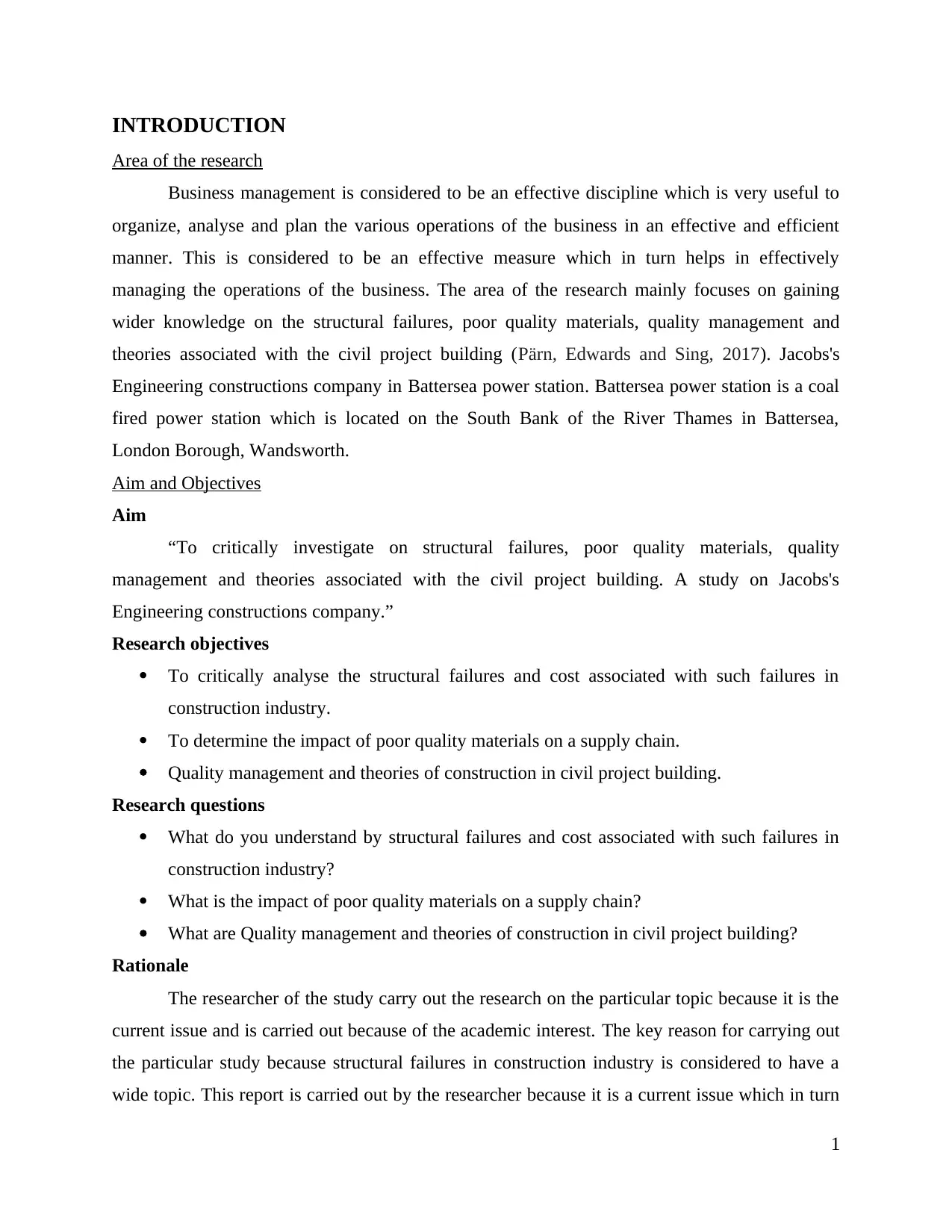
INTRODUCTION
Area of the research
Business management is considered to be an effective discipline which is very useful to
organize, analyse and plan the various operations of the business in an effective and efficient
manner. This is considered to be an effective measure which in turn helps in effectively
managing the operations of the business. The area of the research mainly focuses on gaining
wider knowledge on the structural failures, poor quality materials, quality management and
theories associated with the civil project building (Pärn, Edwards and Sing, 2017). Jacobs's
Engineering constructions company in Battersea power station. Battersea power station is a coal
fired power station which is located on the South Bank of the River Thames in Battersea,
London Borough, Wandsworth.
Aim and Objectives
Aim
“To critically investigate on structural failures, poor quality materials, quality
management and theories associated with the civil project building. A study on Jacobs's
Engineering constructions company.”
Research objectives
To critically analyse the structural failures and cost associated with such failures in
construction industry.
To determine the impact of poor quality materials on a supply chain.
Quality management and theories of construction in civil project building.
Research questions
What do you understand by structural failures and cost associated with such failures in
construction industry?
What is the impact of poor quality materials on a supply chain?
What are Quality management and theories of construction in civil project building?
Rationale
The researcher of the study carry out the research on the particular topic because it is the
current issue and is carried out because of the academic interest. The key reason for carrying out
the particular study because structural failures in construction industry is considered to have a
wide topic. This report is carried out by the researcher because it is a current issue which in turn
1
Area of the research
Business management is considered to be an effective discipline which is very useful to
organize, analyse and plan the various operations of the business in an effective and efficient
manner. This is considered to be an effective measure which in turn helps in effectively
managing the operations of the business. The area of the research mainly focuses on gaining
wider knowledge on the structural failures, poor quality materials, quality management and
theories associated with the civil project building (Pärn, Edwards and Sing, 2017). Jacobs's
Engineering constructions company in Battersea power station. Battersea power station is a coal
fired power station which is located on the South Bank of the River Thames in Battersea,
London Borough, Wandsworth.
Aim and Objectives
Aim
“To critically investigate on structural failures, poor quality materials, quality
management and theories associated with the civil project building. A study on Jacobs's
Engineering constructions company.”
Research objectives
To critically analyse the structural failures and cost associated with such failures in
construction industry.
To determine the impact of poor quality materials on a supply chain.
Quality management and theories of construction in civil project building.
Research questions
What do you understand by structural failures and cost associated with such failures in
construction industry?
What is the impact of poor quality materials on a supply chain?
What are Quality management and theories of construction in civil project building?
Rationale
The researcher of the study carry out the research on the particular topic because it is the
current issue and is carried out because of the academic interest. The key reason for carrying out
the particular study because structural failures in construction industry is considered to have a
wide topic. This report is carried out by the researcher because it is a current issue which in turn
1
⊘ This is a preview!⊘
Do you want full access?
Subscribe today to unlock all pages.

Trusted by 1+ million students worldwide
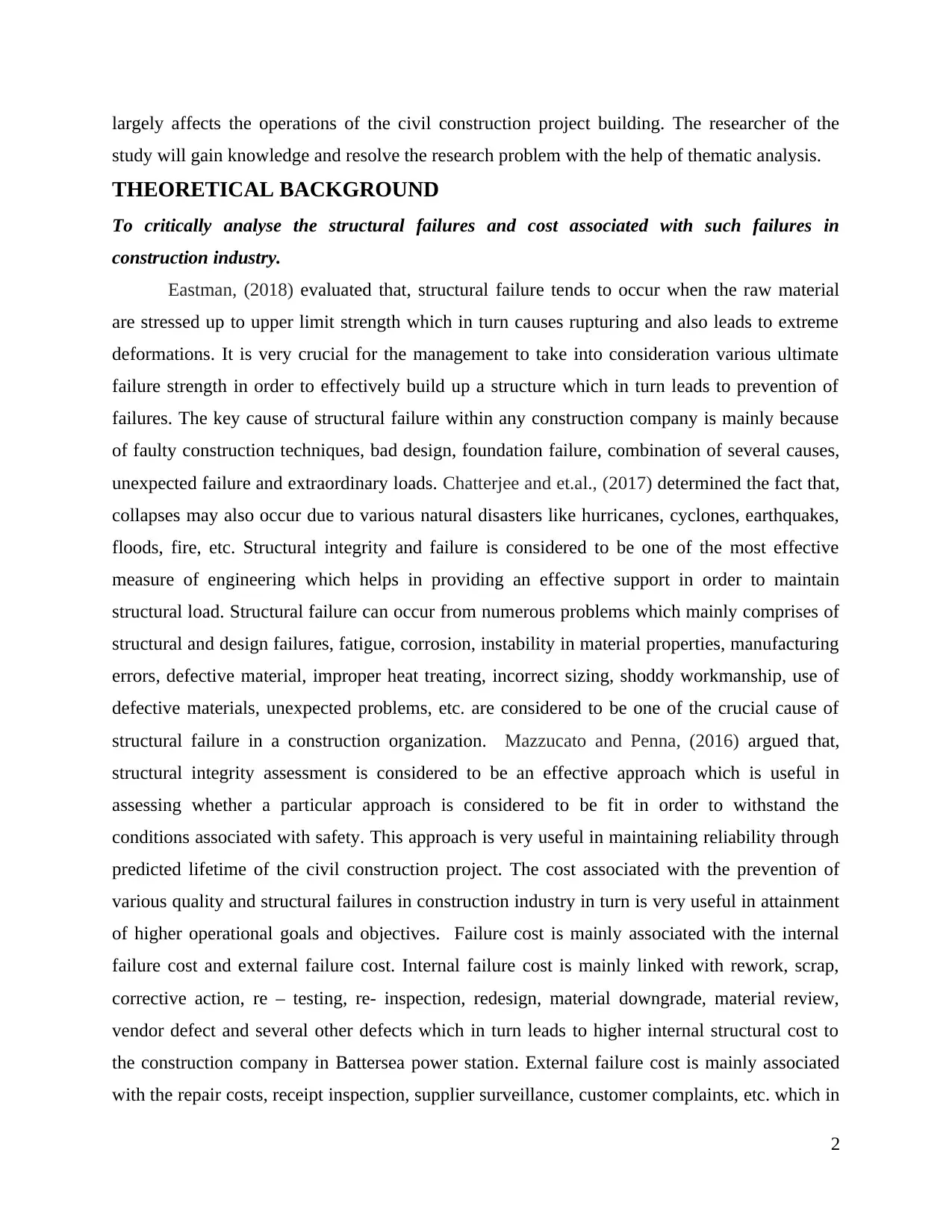
largely affects the operations of the civil construction project building. The researcher of the
study will gain knowledge and resolve the research problem with the help of thematic analysis.
THEORETICAL BACKGROUND
To critically analyse the structural failures and cost associated with such failures in
construction industry.
Eastman, (2018) evaluated that, structural failure tends to occur when the raw material
are stressed up to upper limit strength which in turn causes rupturing and also leads to extreme
deformations. It is very crucial for the management to take into consideration various ultimate
failure strength in order to effectively build up a structure which in turn leads to prevention of
failures. The key cause of structural failure within any construction company is mainly because
of faulty construction techniques, bad design, foundation failure, combination of several causes,
unexpected failure and extraordinary loads. Chatterjee and et.al., (2017) determined the fact that,
collapses may also occur due to various natural disasters like hurricanes, cyclones, earthquakes,
floods, fire, etc. Structural integrity and failure is considered to be one of the most effective
measure of engineering which helps in providing an effective support in order to maintain
structural load. Structural failure can occur from numerous problems which mainly comprises of
structural and design failures, fatigue, corrosion, instability in material properties, manufacturing
errors, defective material, improper heat treating, incorrect sizing, shoddy workmanship, use of
defective materials, unexpected problems, etc. are considered to be one of the crucial cause of
structural failure in a construction organization. Mazzucato and Penna, (2016) argued that,
structural integrity assessment is considered to be an effective approach which is useful in
assessing whether a particular approach is considered to be fit in order to withstand the
conditions associated with safety. This approach is very useful in maintaining reliability through
predicted lifetime of the civil construction project. The cost associated with the prevention of
various quality and structural failures in construction industry in turn is very useful in attainment
of higher operational goals and objectives. Failure cost is mainly associated with the internal
failure cost and external failure cost. Internal failure cost is mainly linked with rework, scrap,
corrective action, re – testing, re- inspection, redesign, material downgrade, material review,
vendor defect and several other defects which in turn leads to higher internal structural cost to
the construction company in Battersea power station. External failure cost is mainly associated
with the repair costs, receipt inspection, supplier surveillance, customer complaints, etc. which in
2
study will gain knowledge and resolve the research problem with the help of thematic analysis.
THEORETICAL BACKGROUND
To critically analyse the structural failures and cost associated with such failures in
construction industry.
Eastman, (2018) evaluated that, structural failure tends to occur when the raw material
are stressed up to upper limit strength which in turn causes rupturing and also leads to extreme
deformations. It is very crucial for the management to take into consideration various ultimate
failure strength in order to effectively build up a structure which in turn leads to prevention of
failures. The key cause of structural failure within any construction company is mainly because
of faulty construction techniques, bad design, foundation failure, combination of several causes,
unexpected failure and extraordinary loads. Chatterjee and et.al., (2017) determined the fact that,
collapses may also occur due to various natural disasters like hurricanes, cyclones, earthquakes,
floods, fire, etc. Structural integrity and failure is considered to be one of the most effective
measure of engineering which helps in providing an effective support in order to maintain
structural load. Structural failure can occur from numerous problems which mainly comprises of
structural and design failures, fatigue, corrosion, instability in material properties, manufacturing
errors, defective material, improper heat treating, incorrect sizing, shoddy workmanship, use of
defective materials, unexpected problems, etc. are considered to be one of the crucial cause of
structural failure in a construction organization. Mazzucato and Penna, (2016) argued that,
structural integrity assessment is considered to be an effective approach which is useful in
assessing whether a particular approach is considered to be fit in order to withstand the
conditions associated with safety. This approach is very useful in maintaining reliability through
predicted lifetime of the civil construction project. The cost associated with the prevention of
various quality and structural failures in construction industry in turn is very useful in attainment
of higher operational goals and objectives. Failure cost is mainly associated with the internal
failure cost and external failure cost. Internal failure cost is mainly linked with rework, scrap,
corrective action, re – testing, re- inspection, redesign, material downgrade, material review,
vendor defect and several other defects which in turn leads to higher internal structural cost to
the construction company in Battersea power station. External failure cost is mainly associated
with the repair costs, receipt inspection, supplier surveillance, customer complaints, etc. which in
2
Paraphrase This Document
Need a fresh take? Get an instant paraphrase of this document with our AI Paraphraser
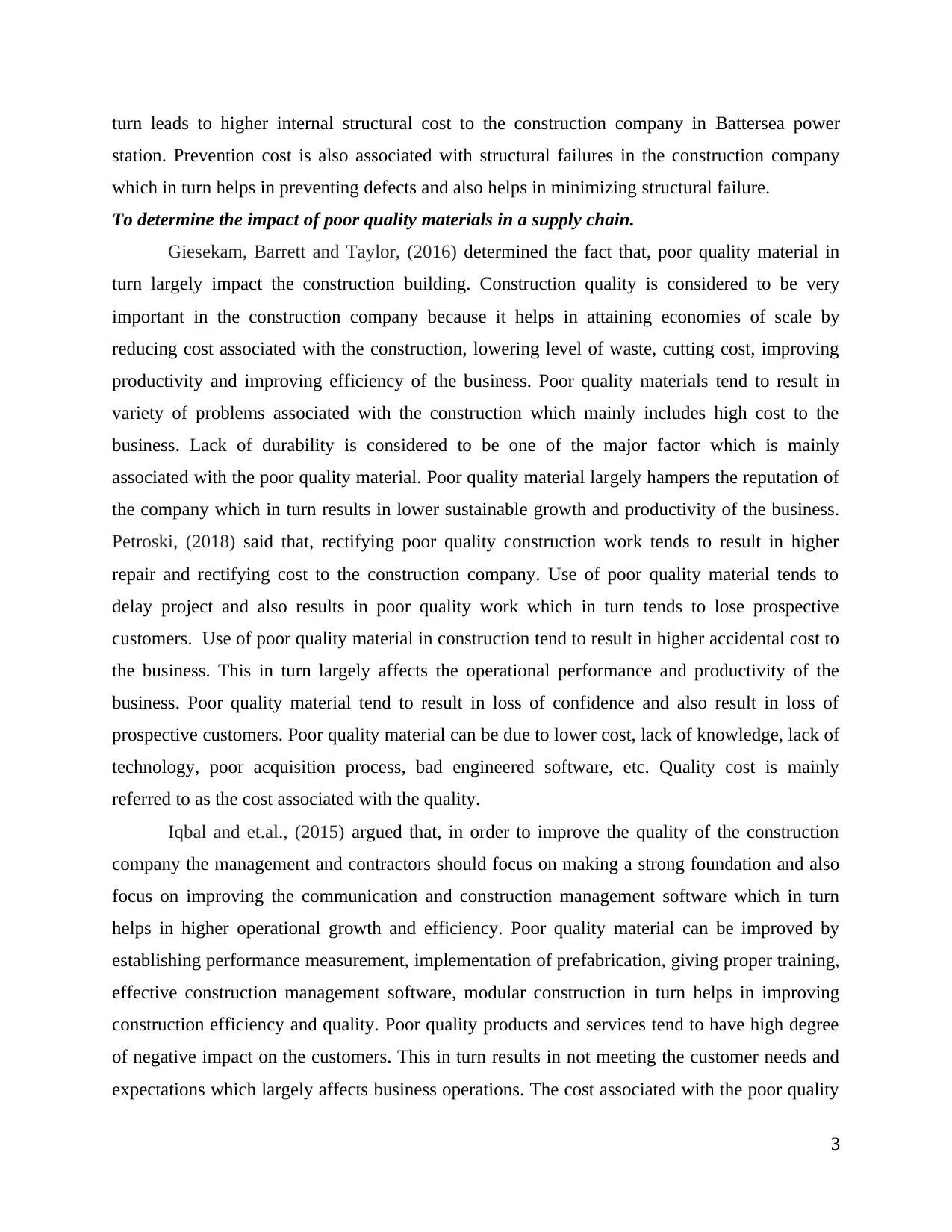
turn leads to higher internal structural cost to the construction company in Battersea power
station. Prevention cost is also associated with structural failures in the construction company
which in turn helps in preventing defects and also helps in minimizing structural failure.
To determine the impact of poor quality materials in a supply chain.
Giesekam, Barrett and Taylor, (2016) determined the fact that, poor quality material in
turn largely impact the construction building. Construction quality is considered to be very
important in the construction company because it helps in attaining economies of scale by
reducing cost associated with the construction, lowering level of waste, cutting cost, improving
productivity and improving efficiency of the business. Poor quality materials tend to result in
variety of problems associated with the construction which mainly includes high cost to the
business. Lack of durability is considered to be one of the major factor which is mainly
associated with the poor quality material. Poor quality material largely hampers the reputation of
the company which in turn results in lower sustainable growth and productivity of the business.
Petroski, (2018) said that, rectifying poor quality construction work tends to result in higher
repair and rectifying cost to the construction company. Use of poor quality material tends to
delay project and also results in poor quality work which in turn tends to lose prospective
customers. Use of poor quality material in construction tend to result in higher accidental cost to
the business. This in turn largely affects the operational performance and productivity of the
business. Poor quality material tend to result in loss of confidence and also result in loss of
prospective customers. Poor quality material can be due to lower cost, lack of knowledge, lack of
technology, poor acquisition process, bad engineered software, etc. Quality cost is mainly
referred to as the cost associated with the quality.
Iqbal and et.al., (2015) argued that, in order to improve the quality of the construction
company the management and contractors should focus on making a strong foundation and also
focus on improving the communication and construction management software which in turn
helps in higher operational growth and efficiency. Poor quality material can be improved by
establishing performance measurement, implementation of prefabrication, giving proper training,
effective construction management software, modular construction in turn helps in improving
construction efficiency and quality. Poor quality products and services tend to have high degree
of negative impact on the customers. This in turn results in not meeting the customer needs and
expectations which largely affects business operations. The cost associated with the poor quality
3
station. Prevention cost is also associated with structural failures in the construction company
which in turn helps in preventing defects and also helps in minimizing structural failure.
To determine the impact of poor quality materials in a supply chain.
Giesekam, Barrett and Taylor, (2016) determined the fact that, poor quality material in
turn largely impact the construction building. Construction quality is considered to be very
important in the construction company because it helps in attaining economies of scale by
reducing cost associated with the construction, lowering level of waste, cutting cost, improving
productivity and improving efficiency of the business. Poor quality materials tend to result in
variety of problems associated with the construction which mainly includes high cost to the
business. Lack of durability is considered to be one of the major factor which is mainly
associated with the poor quality material. Poor quality material largely hampers the reputation of
the company which in turn results in lower sustainable growth and productivity of the business.
Petroski, (2018) said that, rectifying poor quality construction work tends to result in higher
repair and rectifying cost to the construction company. Use of poor quality material tends to
delay project and also results in poor quality work which in turn tends to lose prospective
customers. Use of poor quality material in construction tend to result in higher accidental cost to
the business. This in turn largely affects the operational performance and productivity of the
business. Poor quality material tend to result in loss of confidence and also result in loss of
prospective customers. Poor quality material can be due to lower cost, lack of knowledge, lack of
technology, poor acquisition process, bad engineered software, etc. Quality cost is mainly
referred to as the cost associated with the quality.
Iqbal and et.al., (2015) argued that, in order to improve the quality of the construction
company the management and contractors should focus on making a strong foundation and also
focus on improving the communication and construction management software which in turn
helps in higher operational growth and efficiency. Poor quality material can be improved by
establishing performance measurement, implementation of prefabrication, giving proper training,
effective construction management software, modular construction in turn helps in improving
construction efficiency and quality. Poor quality products and services tend to have high degree
of negative impact on the customers. This in turn results in not meeting the customer needs and
expectations which largely affects business operations. The cost associated with the poor quality
3
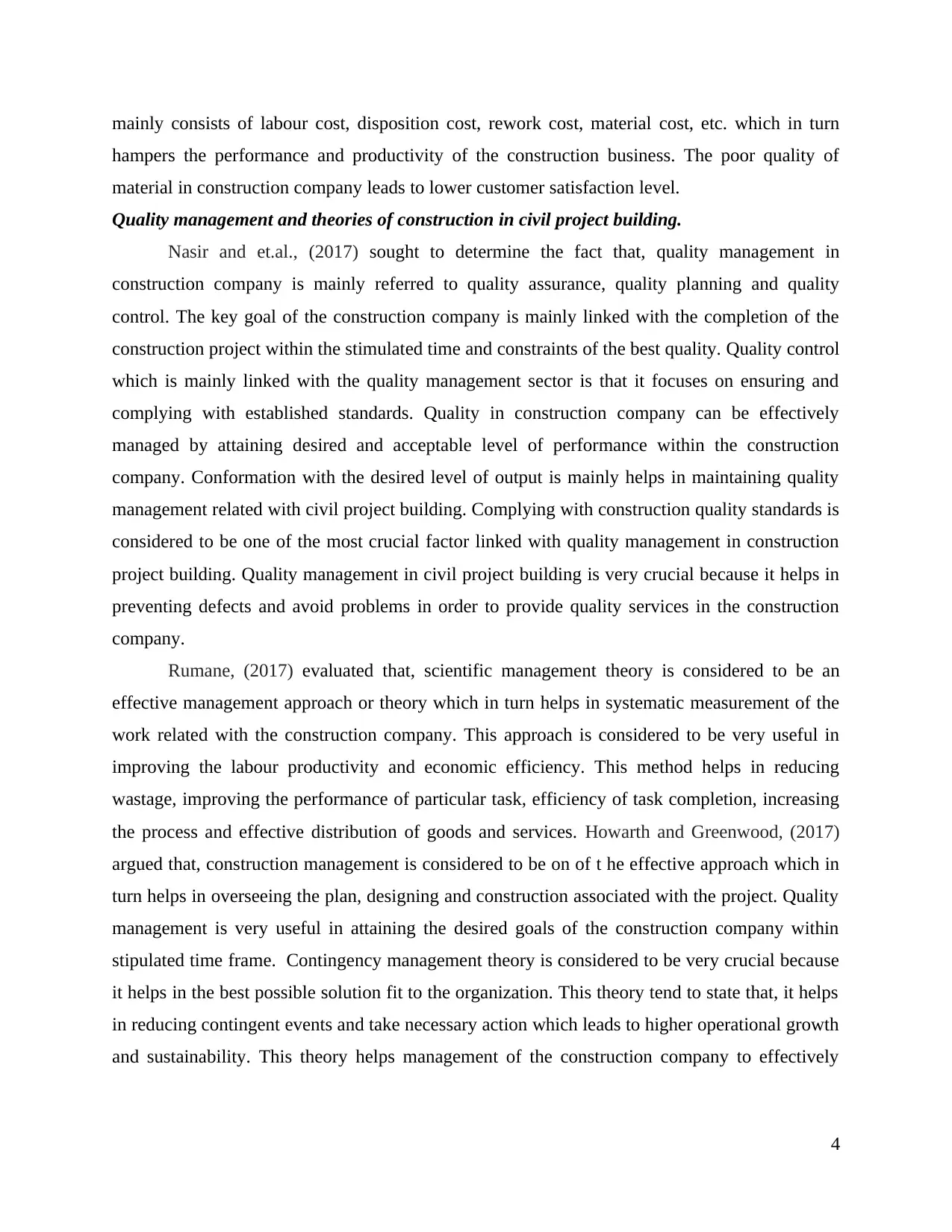
mainly consists of labour cost, disposition cost, rework cost, material cost, etc. which in turn
hampers the performance and productivity of the construction business. The poor quality of
material in construction company leads to lower customer satisfaction level.
Quality management and theories of construction in civil project building.
Nasir and et.al., (2017) sought to determine the fact that, quality management in
construction company is mainly referred to quality assurance, quality planning and quality
control. The key goal of the construction company is mainly linked with the completion of the
construction project within the stimulated time and constraints of the best quality. Quality control
which is mainly linked with the quality management sector is that it focuses on ensuring and
complying with established standards. Quality in construction company can be effectively
managed by attaining desired and acceptable level of performance within the construction
company. Conformation with the desired level of output is mainly helps in maintaining quality
management related with civil project building. Complying with construction quality standards is
considered to be one of the most crucial factor linked with quality management in construction
project building. Quality management in civil project building is very crucial because it helps in
preventing defects and avoid problems in order to provide quality services in the construction
company.
Rumane, (2017) evaluated that, scientific management theory is considered to be an
effective management approach or theory which in turn helps in systematic measurement of the
work related with the construction company. This approach is considered to be very useful in
improving the labour productivity and economic efficiency. This method helps in reducing
wastage, improving the performance of particular task, efficiency of task completion, increasing
the process and effective distribution of goods and services. Howarth and Greenwood, (2017)
argued that, construction management is considered to be on of t he effective approach which in
turn helps in overseeing the plan, designing and construction associated with the project. Quality
management is very useful in attaining the desired goals of the construction company within
stipulated time frame. Contingency management theory is considered to be very crucial because
it helps in the best possible solution fit to the organization. This theory tend to state that, it helps
in reducing contingent events and take necessary action which leads to higher operational growth
and sustainability. This theory helps management of the construction company to effectively
4
hampers the performance and productivity of the construction business. The poor quality of
material in construction company leads to lower customer satisfaction level.
Quality management and theories of construction in civil project building.
Nasir and et.al., (2017) sought to determine the fact that, quality management in
construction company is mainly referred to quality assurance, quality planning and quality
control. The key goal of the construction company is mainly linked with the completion of the
construction project within the stimulated time and constraints of the best quality. Quality control
which is mainly linked with the quality management sector is that it focuses on ensuring and
complying with established standards. Quality in construction company can be effectively
managed by attaining desired and acceptable level of performance within the construction
company. Conformation with the desired level of output is mainly helps in maintaining quality
management related with civil project building. Complying with construction quality standards is
considered to be one of the most crucial factor linked with quality management in construction
project building. Quality management in civil project building is very crucial because it helps in
preventing defects and avoid problems in order to provide quality services in the construction
company.
Rumane, (2017) evaluated that, scientific management theory is considered to be an
effective management approach or theory which in turn helps in systematic measurement of the
work related with the construction company. This approach is considered to be very useful in
improving the labour productivity and economic efficiency. This method helps in reducing
wastage, improving the performance of particular task, efficiency of task completion, increasing
the process and effective distribution of goods and services. Howarth and Greenwood, (2017)
argued that, construction management is considered to be on of t he effective approach which in
turn helps in overseeing the plan, designing and construction associated with the project. Quality
management is very useful in attaining the desired goals of the construction company within
stipulated time frame. Contingency management theory is considered to be very crucial because
it helps in the best possible solution fit to the organization. This theory tend to state that, it helps
in reducing contingent events and take necessary action which leads to higher operational growth
and sustainability. This theory helps management of the construction company to effectively
4
⊘ This is a preview!⊘
Do you want full access?
Subscribe today to unlock all pages.

Trusted by 1+ million students worldwide
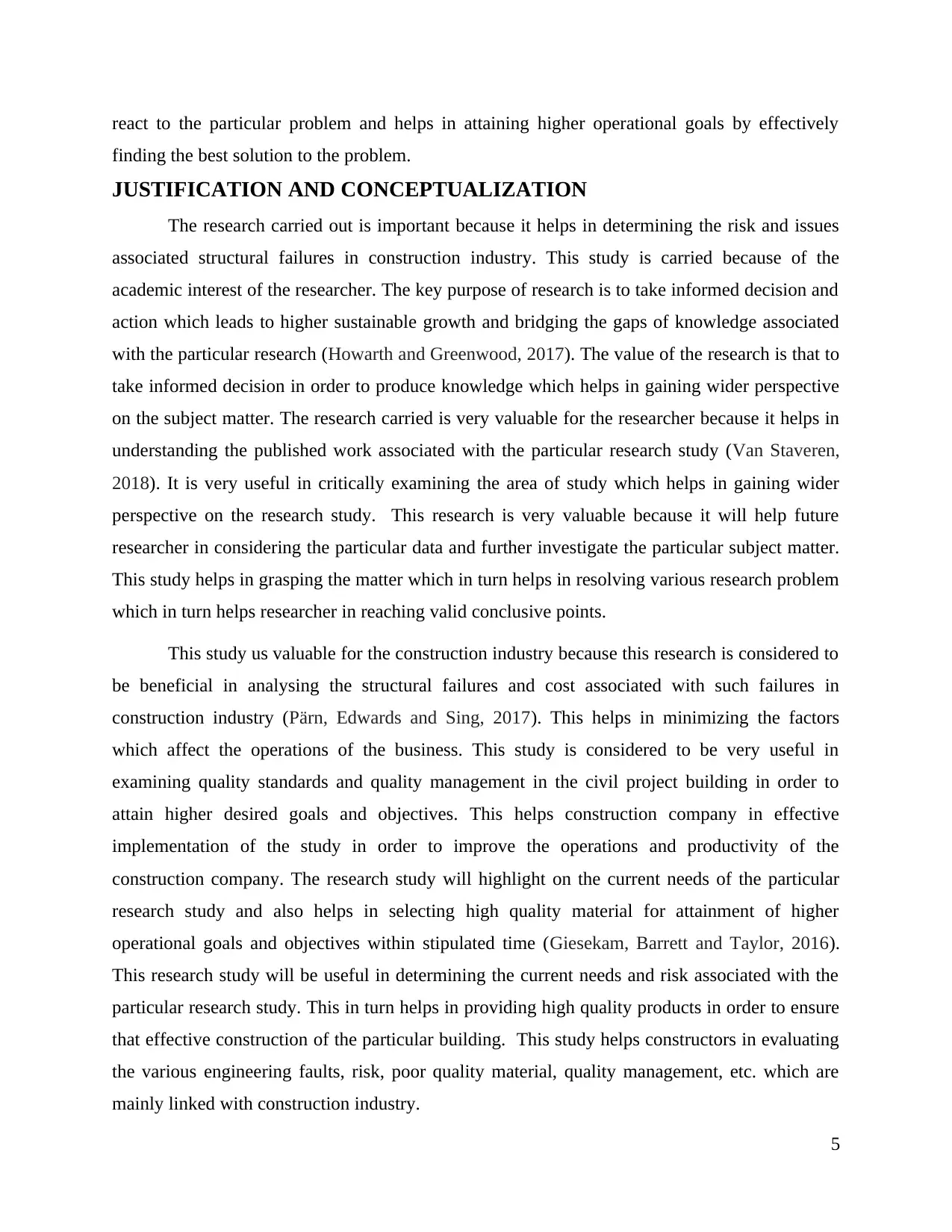
react to the particular problem and helps in attaining higher operational goals by effectively
finding the best solution to the problem.
JUSTIFICATION AND CONCEPTUALIZATION
The research carried out is important because it helps in determining the risk and issues
associated structural failures in construction industry. This study is carried because of the
academic interest of the researcher. The key purpose of research is to take informed decision and
action which leads to higher sustainable growth and bridging the gaps of knowledge associated
with the particular research (Howarth and Greenwood, 2017). The value of the research is that to
take informed decision in order to produce knowledge which helps in gaining wider perspective
on the subject matter. The research carried is very valuable for the researcher because it helps in
understanding the published work associated with the particular research study (Van Staveren,
2018). It is very useful in critically examining the area of study which helps in gaining wider
perspective on the research study. This research is very valuable because it will help future
researcher in considering the particular data and further investigate the particular subject matter.
This study helps in grasping the matter which in turn helps in resolving various research problem
which in turn helps researcher in reaching valid conclusive points.
This study us valuable for the construction industry because this research is considered to
be beneficial in analysing the structural failures and cost associated with such failures in
construction industry (Pärn, Edwards and Sing, 2017). This helps in minimizing the factors
which affect the operations of the business. This study is considered to be very useful in
examining quality standards and quality management in the civil project building in order to
attain higher desired goals and objectives. This helps construction company in effective
implementation of the study in order to improve the operations and productivity of the
construction company. The research study will highlight on the current needs of the particular
research study and also helps in selecting high quality material for attainment of higher
operational goals and objectives within stipulated time (Giesekam, Barrett and Taylor, 2016).
This research study will be useful in determining the current needs and risk associated with the
particular research study. This in turn helps in providing high quality products in order to ensure
that effective construction of the particular building. This study helps constructors in evaluating
the various engineering faults, risk, poor quality material, quality management, etc. which are
mainly linked with construction industry.
5
finding the best solution to the problem.
JUSTIFICATION AND CONCEPTUALIZATION
The research carried out is important because it helps in determining the risk and issues
associated structural failures in construction industry. This study is carried because of the
academic interest of the researcher. The key purpose of research is to take informed decision and
action which leads to higher sustainable growth and bridging the gaps of knowledge associated
with the particular research (Howarth and Greenwood, 2017). The value of the research is that to
take informed decision in order to produce knowledge which helps in gaining wider perspective
on the subject matter. The research carried is very valuable for the researcher because it helps in
understanding the published work associated with the particular research study (Van Staveren,
2018). It is very useful in critically examining the area of study which helps in gaining wider
perspective on the research study. This research is very valuable because it will help future
researcher in considering the particular data and further investigate the particular subject matter.
This study helps in grasping the matter which in turn helps in resolving various research problem
which in turn helps researcher in reaching valid conclusive points.
This study us valuable for the construction industry because this research is considered to
be beneficial in analysing the structural failures and cost associated with such failures in
construction industry (Pärn, Edwards and Sing, 2017). This helps in minimizing the factors
which affect the operations of the business. This study is considered to be very useful in
examining quality standards and quality management in the civil project building in order to
attain higher desired goals and objectives. This helps construction company in effective
implementation of the study in order to improve the operations and productivity of the
construction company. The research study will highlight on the current needs of the particular
research study and also helps in selecting high quality material for attainment of higher
operational goals and objectives within stipulated time (Giesekam, Barrett and Taylor, 2016).
This research study will be useful in determining the current needs and risk associated with the
particular research study. This in turn helps in providing high quality products in order to ensure
that effective construction of the particular building. This study helps constructors in evaluating
the various engineering faults, risk, poor quality material, quality management, etc. which are
mainly linked with construction industry.
5
Paraphrase This Document
Need a fresh take? Get an instant paraphrase of this document with our AI Paraphraser
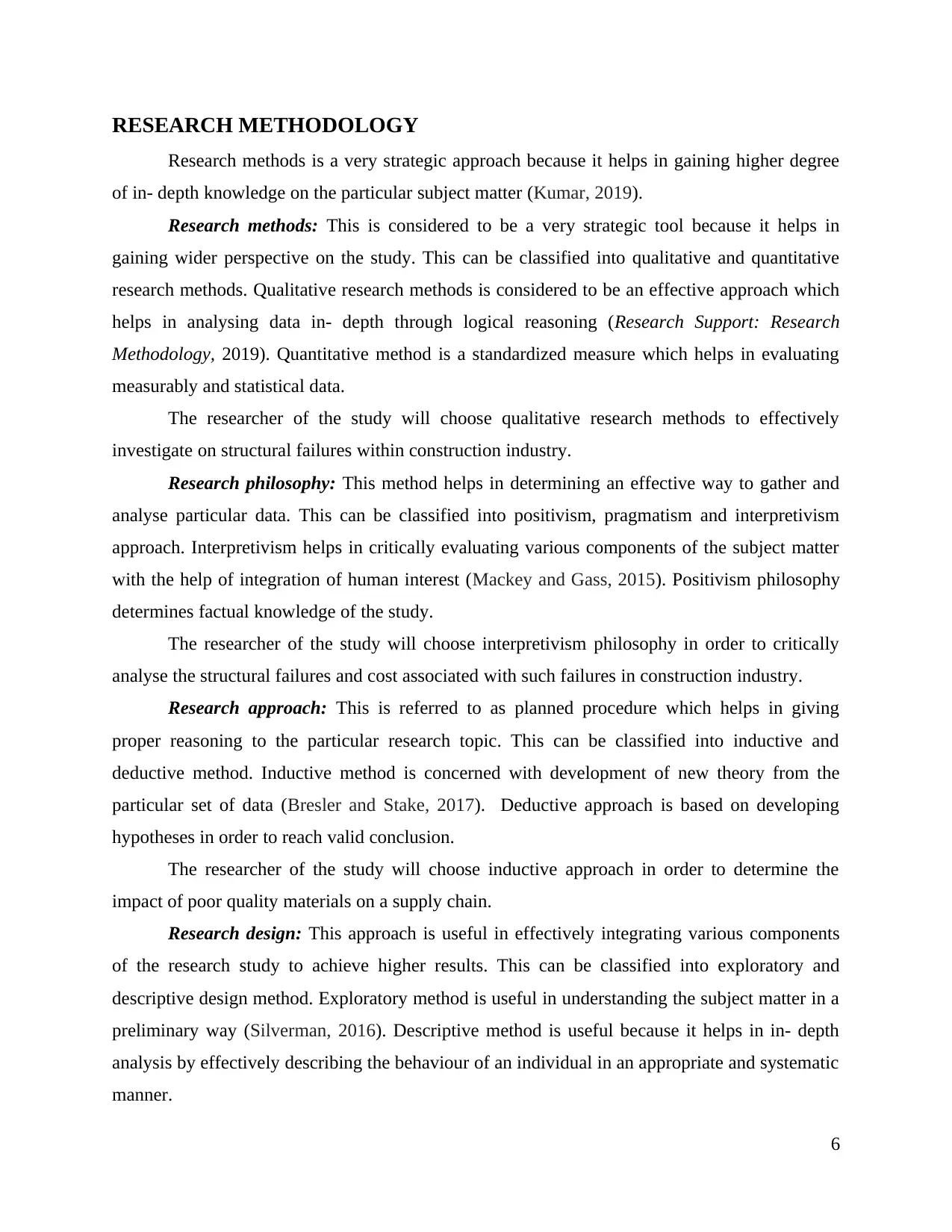
RESEARCH METHODOLOGY
Research methods is a very strategic approach because it helps in gaining higher degree
of in- depth knowledge on the particular subject matter (Kumar, 2019).
Research methods: This is considered to be a very strategic tool because it helps in
gaining wider perspective on the study. This can be classified into qualitative and quantitative
research methods. Qualitative research methods is considered to be an effective approach which
helps in analysing data in- depth through logical reasoning (Research Support: Research
Methodology, 2019). Quantitative method is a standardized measure which helps in evaluating
measurably and statistical data.
The researcher of the study will choose qualitative research methods to effectively
investigate on structural failures within construction industry.
Research philosophy: This method helps in determining an effective way to gather and
analyse particular data. This can be classified into positivism, pragmatism and interpretivism
approach. Interpretivism helps in critically evaluating various components of the subject matter
with the help of integration of human interest (Mackey and Gass, 2015). Positivism philosophy
determines factual knowledge of the study.
The researcher of the study will choose interpretivism philosophy in order to critically
analyse the structural failures and cost associated with such failures in construction industry.
Research approach: This is referred to as planned procedure which helps in giving
proper reasoning to the particular research topic. This can be classified into inductive and
deductive method. Inductive method is concerned with development of new theory from the
particular set of data (Bresler and Stake, 2017). Deductive approach is based on developing
hypotheses in order to reach valid conclusion.
The researcher of the study will choose inductive approach in order to determine the
impact of poor quality materials on a supply chain.
Research design: This approach is useful in effectively integrating various components
of the research study to achieve higher results. This can be classified into exploratory and
descriptive design method. Exploratory method is useful in understanding the subject matter in a
preliminary way (Silverman, 2016). Descriptive method is useful because it helps in in- depth
analysis by effectively describing the behaviour of an individual in an appropriate and systematic
manner.
6
Research methods is a very strategic approach because it helps in gaining higher degree
of in- depth knowledge on the particular subject matter (Kumar, 2019).
Research methods: This is considered to be a very strategic tool because it helps in
gaining wider perspective on the study. This can be classified into qualitative and quantitative
research methods. Qualitative research methods is considered to be an effective approach which
helps in analysing data in- depth through logical reasoning (Research Support: Research
Methodology, 2019). Quantitative method is a standardized measure which helps in evaluating
measurably and statistical data.
The researcher of the study will choose qualitative research methods to effectively
investigate on structural failures within construction industry.
Research philosophy: This method helps in determining an effective way to gather and
analyse particular data. This can be classified into positivism, pragmatism and interpretivism
approach. Interpretivism helps in critically evaluating various components of the subject matter
with the help of integration of human interest (Mackey and Gass, 2015). Positivism philosophy
determines factual knowledge of the study.
The researcher of the study will choose interpretivism philosophy in order to critically
analyse the structural failures and cost associated with such failures in construction industry.
Research approach: This is referred to as planned procedure which helps in giving
proper reasoning to the particular research topic. This can be classified into inductive and
deductive method. Inductive method is concerned with development of new theory from the
particular set of data (Bresler and Stake, 2017). Deductive approach is based on developing
hypotheses in order to reach valid conclusion.
The researcher of the study will choose inductive approach in order to determine the
impact of poor quality materials on a supply chain.
Research design: This approach is useful in effectively integrating various components
of the research study to achieve higher results. This can be classified into exploratory and
descriptive design method. Exploratory method is useful in understanding the subject matter in a
preliminary way (Silverman, 2016). Descriptive method is useful because it helps in in- depth
analysis by effectively describing the behaviour of an individual in an appropriate and systematic
manner.
6
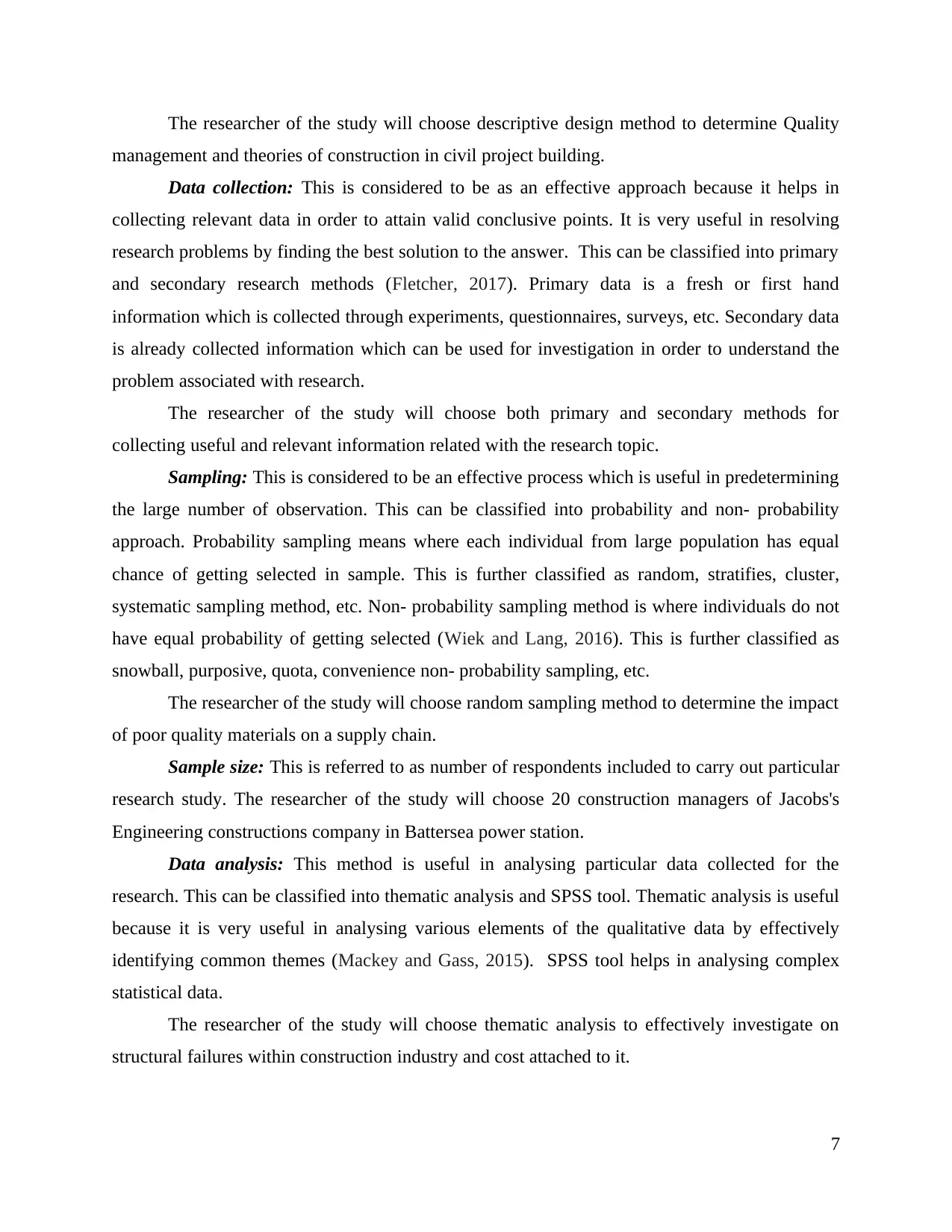
The researcher of the study will choose descriptive design method to determine Quality
management and theories of construction in civil project building.
Data collection: This is considered to be as an effective approach because it helps in
collecting relevant data in order to attain valid conclusive points. It is very useful in resolving
research problems by finding the best solution to the answer. This can be classified into primary
and secondary research methods (Fletcher, 2017). Primary data is a fresh or first hand
information which is collected through experiments, questionnaires, surveys, etc. Secondary data
is already collected information which can be used for investigation in order to understand the
problem associated with research.
The researcher of the study will choose both primary and secondary methods for
collecting useful and relevant information related with the research topic.
Sampling: This is considered to be an effective process which is useful in predetermining
the large number of observation. This can be classified into probability and non- probability
approach. Probability sampling means where each individual from large population has equal
chance of getting selected in sample. This is further classified as random, stratifies, cluster,
systematic sampling method, etc. Non- probability sampling method is where individuals do not
have equal probability of getting selected (Wiek and Lang, 2016). This is further classified as
snowball, purposive, quota, convenience non- probability sampling, etc.
The researcher of the study will choose random sampling method to determine the impact
of poor quality materials on a supply chain.
Sample size: This is referred to as number of respondents included to carry out particular
research study. The researcher of the study will choose 20 construction managers of Jacobs's
Engineering constructions company in Battersea power station.
Data analysis: This method is useful in analysing particular data collected for the
research. This can be classified into thematic analysis and SPSS tool. Thematic analysis is useful
because it is very useful in analysing various elements of the qualitative data by effectively
identifying common themes (Mackey and Gass, 2015). SPSS tool helps in analysing complex
statistical data.
The researcher of the study will choose thematic analysis to effectively investigate on
structural failures within construction industry and cost attached to it.
7
management and theories of construction in civil project building.
Data collection: This is considered to be as an effective approach because it helps in
collecting relevant data in order to attain valid conclusive points. It is very useful in resolving
research problems by finding the best solution to the answer. This can be classified into primary
and secondary research methods (Fletcher, 2017). Primary data is a fresh or first hand
information which is collected through experiments, questionnaires, surveys, etc. Secondary data
is already collected information which can be used for investigation in order to understand the
problem associated with research.
The researcher of the study will choose both primary and secondary methods for
collecting useful and relevant information related with the research topic.
Sampling: This is considered to be an effective process which is useful in predetermining
the large number of observation. This can be classified into probability and non- probability
approach. Probability sampling means where each individual from large population has equal
chance of getting selected in sample. This is further classified as random, stratifies, cluster,
systematic sampling method, etc. Non- probability sampling method is where individuals do not
have equal probability of getting selected (Wiek and Lang, 2016). This is further classified as
snowball, purposive, quota, convenience non- probability sampling, etc.
The researcher of the study will choose random sampling method to determine the impact
of poor quality materials on a supply chain.
Sample size: This is referred to as number of respondents included to carry out particular
research study. The researcher of the study will choose 20 construction managers of Jacobs's
Engineering constructions company in Battersea power station.
Data analysis: This method is useful in analysing particular data collected for the
research. This can be classified into thematic analysis and SPSS tool. Thematic analysis is useful
because it is very useful in analysing various elements of the qualitative data by effectively
identifying common themes (Mackey and Gass, 2015). SPSS tool helps in analysing complex
statistical data.
The researcher of the study will choose thematic analysis to effectively investigate on
structural failures within construction industry and cost attached to it.
7
⊘ This is a preview!⊘
Do you want full access?
Subscribe today to unlock all pages.

Trusted by 1+ million students worldwide
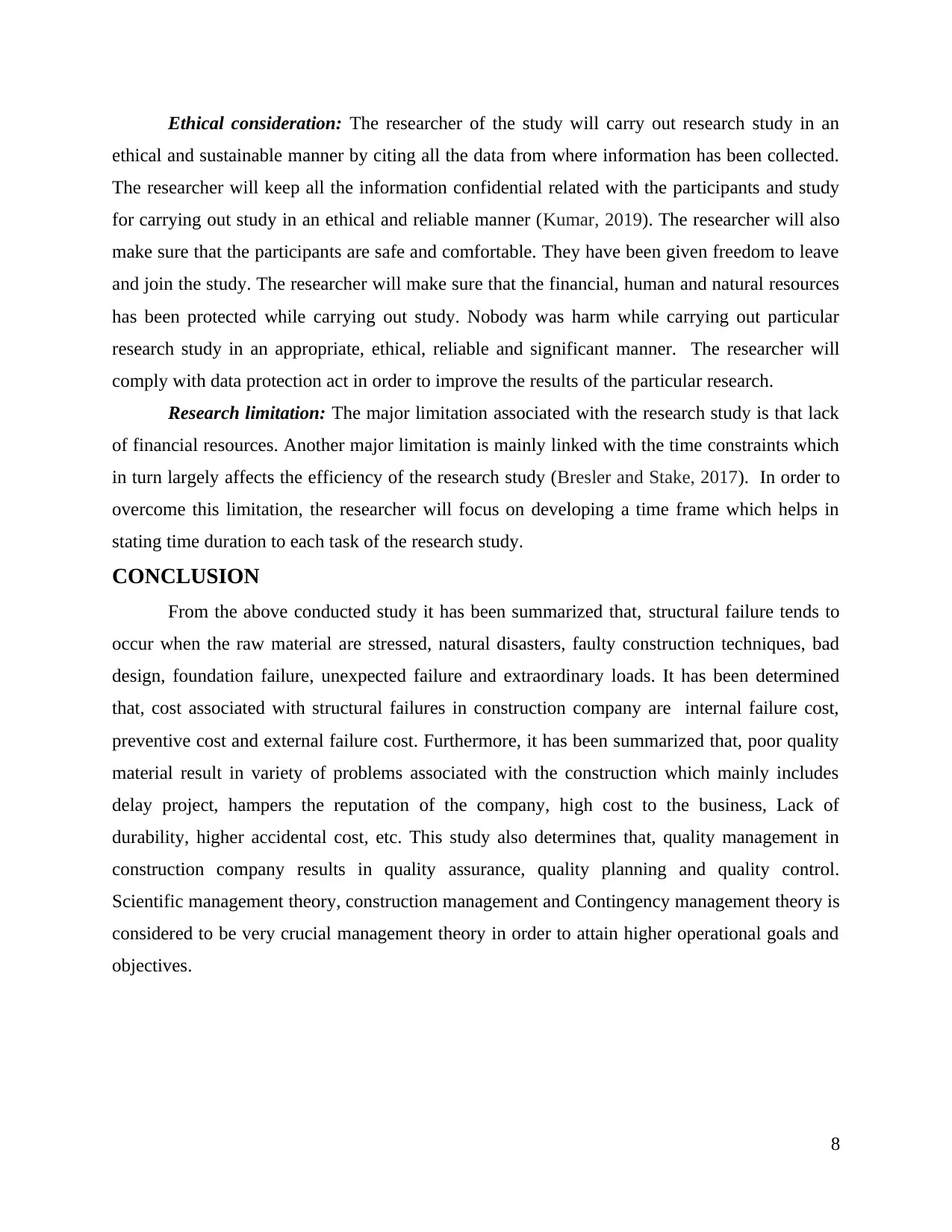
Ethical consideration: The researcher of the study will carry out research study in an
ethical and sustainable manner by citing all the data from where information has been collected.
The researcher will keep all the information confidential related with the participants and study
for carrying out study in an ethical and reliable manner (Kumar, 2019). The researcher will also
make sure that the participants are safe and comfortable. They have been given freedom to leave
and join the study. The researcher will make sure that the financial, human and natural resources
has been protected while carrying out study. Nobody was harm while carrying out particular
research study in an appropriate, ethical, reliable and significant manner. The researcher will
comply with data protection act in order to improve the results of the particular research.
Research limitation: The major limitation associated with the research study is that lack
of financial resources. Another major limitation is mainly linked with the time constraints which
in turn largely affects the efficiency of the research study (Bresler and Stake, 2017). In order to
overcome this limitation, the researcher will focus on developing a time frame which helps in
stating time duration to each task of the research study.
CONCLUSION
From the above conducted study it has been summarized that, structural failure tends to
occur when the raw material are stressed, natural disasters, faulty construction techniques, bad
design, foundation failure, unexpected failure and extraordinary loads. It has been determined
that, cost associated with structural failures in construction company are internal failure cost,
preventive cost and external failure cost. Furthermore, it has been summarized that, poor quality
material result in variety of problems associated with the construction which mainly includes
delay project, hampers the reputation of the company, high cost to the business, Lack of
durability, higher accidental cost, etc. This study also determines that, quality management in
construction company results in quality assurance, quality planning and quality control.
Scientific management theory, construction management and Contingency management theory is
considered to be very crucial management theory in order to attain higher operational goals and
objectives.
8
ethical and sustainable manner by citing all the data from where information has been collected.
The researcher will keep all the information confidential related with the participants and study
for carrying out study in an ethical and reliable manner (Kumar, 2019). The researcher will also
make sure that the participants are safe and comfortable. They have been given freedom to leave
and join the study. The researcher will make sure that the financial, human and natural resources
has been protected while carrying out study. Nobody was harm while carrying out particular
research study in an appropriate, ethical, reliable and significant manner. The researcher will
comply with data protection act in order to improve the results of the particular research.
Research limitation: The major limitation associated with the research study is that lack
of financial resources. Another major limitation is mainly linked with the time constraints which
in turn largely affects the efficiency of the research study (Bresler and Stake, 2017). In order to
overcome this limitation, the researcher will focus on developing a time frame which helps in
stating time duration to each task of the research study.
CONCLUSION
From the above conducted study it has been summarized that, structural failure tends to
occur when the raw material are stressed, natural disasters, faulty construction techniques, bad
design, foundation failure, unexpected failure and extraordinary loads. It has been determined
that, cost associated with structural failures in construction company are internal failure cost,
preventive cost and external failure cost. Furthermore, it has been summarized that, poor quality
material result in variety of problems associated with the construction which mainly includes
delay project, hampers the reputation of the company, high cost to the business, Lack of
durability, higher accidental cost, etc. This study also determines that, quality management in
construction company results in quality assurance, quality planning and quality control.
Scientific management theory, construction management and Contingency management theory is
considered to be very crucial management theory in order to attain higher operational goals and
objectives.
8
Paraphrase This Document
Need a fresh take? Get an instant paraphrase of this document with our AI Paraphraser
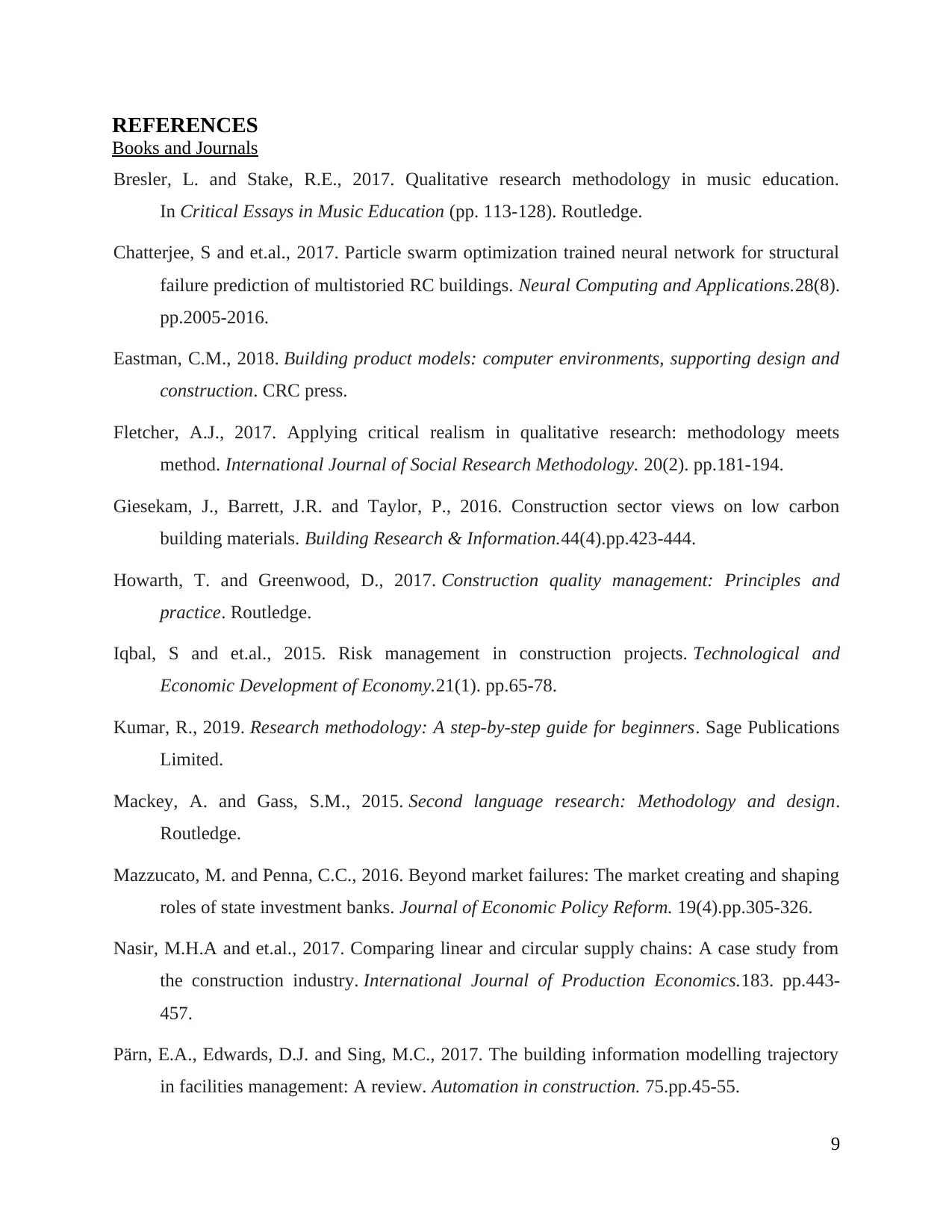
REFERENCES
Books and Journals
Bresler, L. and Stake, R.E., 2017. Qualitative research methodology in music education.
In Critical Essays in Music Education (pp. 113-128). Routledge.
Chatterjee, S and et.al., 2017. Particle swarm optimization trained neural network for structural
failure prediction of multistoried RC buildings. Neural Computing and Applications.28(8).
pp.2005-2016.
Eastman, C.M., 2018. Building product models: computer environments, supporting design and
construction. CRC press.
Fletcher, A.J., 2017. Applying critical realism in qualitative research: methodology meets
method. International Journal of Social Research Methodology. 20(2). pp.181-194.
Giesekam, J., Barrett, J.R. and Taylor, P., 2016. Construction sector views on low carbon
building materials. Building Research & Information.44(4).pp.423-444.
Howarth, T. and Greenwood, D., 2017. Construction quality management: Principles and
practice. Routledge.
Iqbal, S and et.al., 2015. Risk management in construction projects. Technological and
Economic Development of Economy.21(1). pp.65-78.
Kumar, R., 2019. Research methodology: A step-by-step guide for beginners. Sage Publications
Limited.
Mackey, A. and Gass, S.M., 2015. Second language research: Methodology and design.
Routledge.
Mazzucato, M. and Penna, C.C., 2016. Beyond market failures: The market creating and shaping
roles of state investment banks. Journal of Economic Policy Reform. 19(4).pp.305-326.
Nasir, M.H.A and et.al., 2017. Comparing linear and circular supply chains: A case study from
the construction industry. International Journal of Production Economics.183. pp.443-
457.
Pärn, E.A., Edwards, D.J. and Sing, M.C., 2017. The building information modelling trajectory
in facilities management: A review. Automation in construction. 75.pp.45-55.
9
Books and Journals
Bresler, L. and Stake, R.E., 2017. Qualitative research methodology in music education.
In Critical Essays in Music Education (pp. 113-128). Routledge.
Chatterjee, S and et.al., 2017. Particle swarm optimization trained neural network for structural
failure prediction of multistoried RC buildings. Neural Computing and Applications.28(8).
pp.2005-2016.
Eastman, C.M., 2018. Building product models: computer environments, supporting design and
construction. CRC press.
Fletcher, A.J., 2017. Applying critical realism in qualitative research: methodology meets
method. International Journal of Social Research Methodology. 20(2). pp.181-194.
Giesekam, J., Barrett, J.R. and Taylor, P., 2016. Construction sector views on low carbon
building materials. Building Research & Information.44(4).pp.423-444.
Howarth, T. and Greenwood, D., 2017. Construction quality management: Principles and
practice. Routledge.
Iqbal, S and et.al., 2015. Risk management in construction projects. Technological and
Economic Development of Economy.21(1). pp.65-78.
Kumar, R., 2019. Research methodology: A step-by-step guide for beginners. Sage Publications
Limited.
Mackey, A. and Gass, S.M., 2015. Second language research: Methodology and design.
Routledge.
Mazzucato, M. and Penna, C.C., 2016. Beyond market failures: The market creating and shaping
roles of state investment banks. Journal of Economic Policy Reform. 19(4).pp.305-326.
Nasir, M.H.A and et.al., 2017. Comparing linear and circular supply chains: A case study from
the construction industry. International Journal of Production Economics.183. pp.443-
457.
Pärn, E.A., Edwards, D.J. and Sing, M.C., 2017. The building information modelling trajectory
in facilities management: A review. Automation in construction. 75.pp.45-55.
9
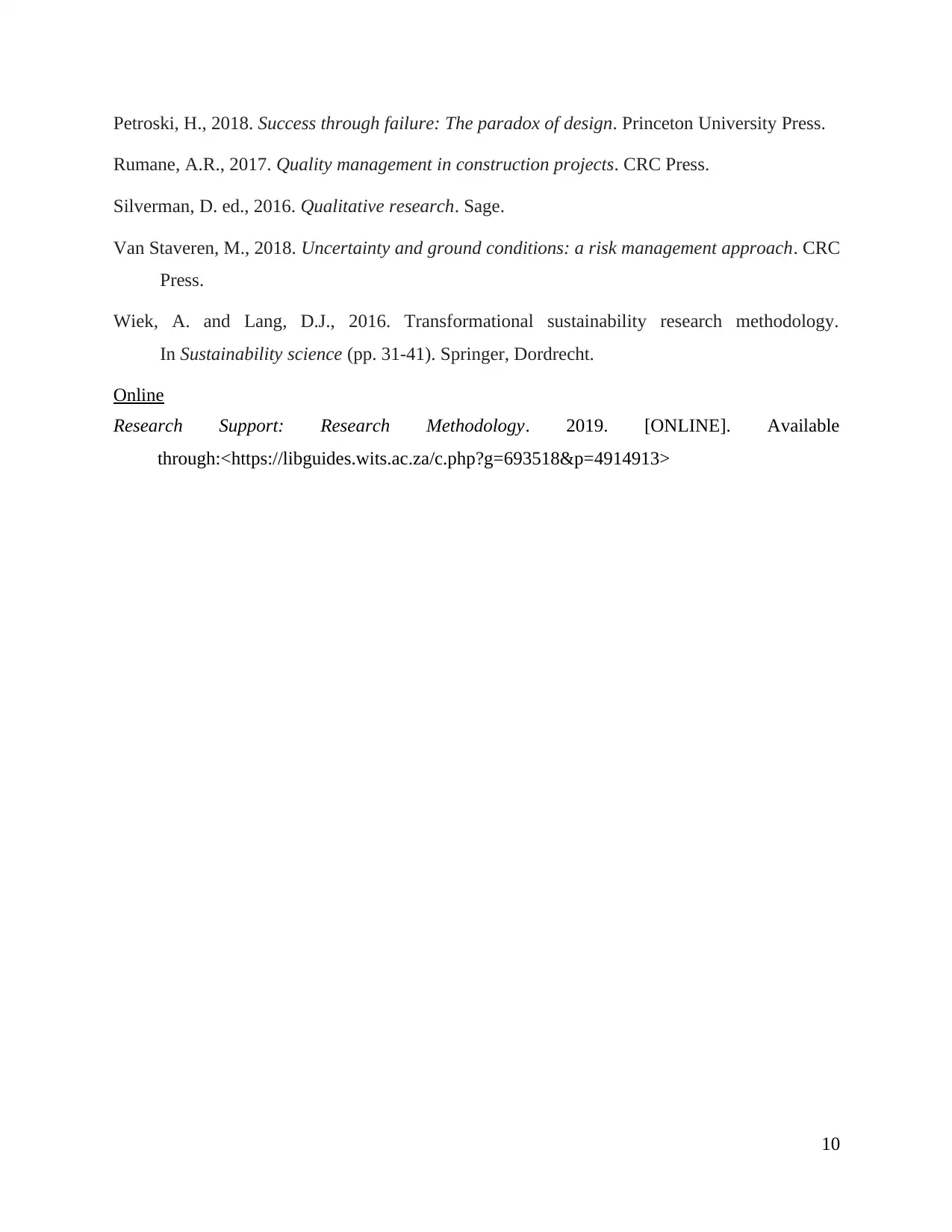
Petroski, H., 2018. Success through failure: The paradox of design. Princeton University Press.
Rumane, A.R., 2017. Quality management in construction projects. CRC Press.
Silverman, D. ed., 2016. Qualitative research. Sage.
Van Staveren, M., 2018. Uncertainty and ground conditions: a risk management approach. CRC
Press.
Wiek, A. and Lang, D.J., 2016. Transformational sustainability research methodology.
In Sustainability science (pp. 31-41). Springer, Dordrecht.
Online
Research Support: Research Methodology. 2019. [ONLINE]. Available
through:<https://libguides.wits.ac.za/c.php?g=693518&p=4914913>
10
Rumane, A.R., 2017. Quality management in construction projects. CRC Press.
Silverman, D. ed., 2016. Qualitative research. Sage.
Van Staveren, M., 2018. Uncertainty and ground conditions: a risk management approach. CRC
Press.
Wiek, A. and Lang, D.J., 2016. Transformational sustainability research methodology.
In Sustainability science (pp. 31-41). Springer, Dordrecht.
Online
Research Support: Research Methodology. 2019. [ONLINE]. Available
through:<https://libguides.wits.ac.za/c.php?g=693518&p=4914913>
10
⊘ This is a preview!⊘
Do you want full access?
Subscribe today to unlock all pages.

Trusted by 1+ million students worldwide
1 out of 12
Related Documents
Your All-in-One AI-Powered Toolkit for Academic Success.
+13062052269
info@desklib.com
Available 24*7 on WhatsApp / Email
![[object Object]](/_next/static/media/star-bottom.7253800d.svg)
Unlock your academic potential
Copyright © 2020–2025 A2Z Services. All Rights Reserved. Developed and managed by ZUCOL.




